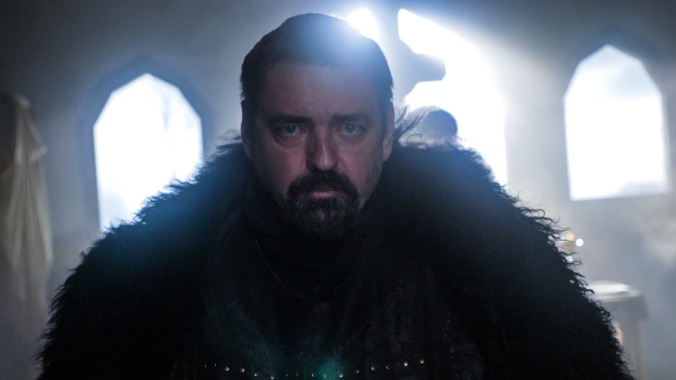Braveheart gets another sort-of sequel with the meager Robert The Bruce


The first time 14th-century Scottish outlaw/king Robert The Bruce is seen in the new film that bears his name, he’s the subject of a bedtime story. The movie opens with widowed Scottish peasant Morag (Anna Hutchison) spinning a yarn for the benefit of her family, a near-mythic tale of Robert The Bruce vanquishing an enemy. (Baron John Comyn, played by Jared Harris in a thankless cameo, apparently must be dispatched night after night so that Bruce can keep claiming that throne.) Historical dramas often fictionalize with such overblown grandiosity that Robert The Bruce feels uncommonly straightforward just by acknowledging that its hero has a reputation based on oft-repeated legends as much as facts.
Meanwhile, the film reveals that the real Bruce (Angus Macfadyen, in both Morag’s tale and the movie’s reality) is in much more dire straits. After years of fighting the English and various clans throughout Scotland, he’s ready to disband his dwindling army, a faction of which immediately decides to turn him in for the handsome reward. The ensuing skirmish leads a wounded Bruce to none other than Morag’s modest shack. There, he comes face to face with the common people he’s supposed to be fighting for.
Eventually, that is. The movie undermines its intimate take on a historical figure with villain switch-ups and character introductions that last well past the 30-minute mark. By the time its throat is cleared, with Bruce’s and Morag’s families ready to finally intersect, the movie is half over. Even that pivotal first encounter is dragged out by Morag’s monologue explaining the tortured specifics of her familial relationships—how she looks after her young son, Scot (Gabriel Bateman), as well as her dead brother’s slightly older children, and that they’re all menaced by her dead husband’s brother, who threatens to conscript Scot into his anti-Bruce campaign. Given how little comes of these characters, it all sounds suspiciously like a lengthy excuse for not casting a middle-age actress as Morag.
If the film’s relationships are more expositional than emotional, Robert The Bruce does gain an extra-textual dimension from its oddball connections to other, more epically inclined historical dramas about this time period. Macfadyen previously played Robert The Bruce in Mel Gibson’s Oscar-winning Braveheart, where he was depicted as a conflicted man inspired by Gibson’s William Wallace to rise to the cause of Scottish independence. Here, Macfadyen reprises the role and co-writes the screenplay, taking custody of a character he played 25 years ago for a story that casts Bruce in a more favorable light. After years of war, his personal commitment to Scotland remains, but his willingness to sacrifice more men is wavering. Macfadyen playing the part after all these years makes Robert The Bruce part decades-later curiosity, part opportunistic DTV-style sequel. The film also follows Outlaw King, a recent film about Bruce that does a credible job of bridging the time gap between Macfadyen’s two cracks at the role.
Robert The Bruce doesn’t have much in common with either of its sort-of predecessors, in style (snowy desolation) or in tone (quieter; less, though not zero, inspirational speechifying). But its cinematic ancestry isn’t a bad starting place for a movie partially about living up to tales of battlefield glory and righteous triumph; the interplay it creates between tangentially related past works is the best thing about it. Remove Robert The Bruce from its slot in the ongoing European History Cinematic Universe, and its story becomes, at times, downright inexplicable. The entwining of Bruce’s destiny with Morag and Scot is thrown off not by the king’s oversized presence—Macfadyen spends a fair chunk of the movie offscreen or prone—but by the true-believer bedroom eyes Morag keeps throwing his way.
Hutchison, gently put, does not deliver the kind of performance that a movie can be adequately built around while its hero recovers from a stab wound. It doesn’t help that director Richard Gray diffuses so much of the action, sometimes with erratic check-in edits to keep track of his many characters. The screenplay also introduces ill-advised spiritual elements, saddling Morag with premonitions and brief conferences with a witchlike mystic (Melora Walters from Magnolia) about the fate of her young son. The movie presents its central family with an intense test of loyalty, only to ramble on about destiny up through its abrupt attempts at a tearjerking denouement.
For an uncertainly paced and fabricated historical side quest, much of Robert The Bruce is painlessly watchable. Sometimes it even goes so far as to cleverly remodel its genre, with a medieval home-invasion sequence and a pre-battle speech issued to half a dozen civilians rather than legions of soldiers. The movie’s simplest moments are so effective that its subplots and many extraneous characters resemble elaborate window dressing. It’s as if the filmmakers became convinced that without an obligatory cast of faceless moving pieces, it simply wouldn’t count as historical fiction.